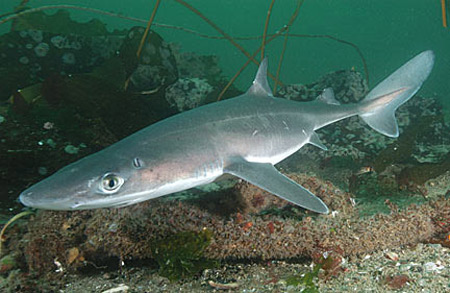Dogfish Problem Moves to Amendment
by Laurie Schreiber

The New England Fishery Management Council (NEFMC) approved a range of alternatives for inclusion in the Draft Environmental Impact Statement for Amendment 3 to the Spiny Dogfish fishery management plan, at its April 24-26 meeting.
The document will be the subject of public review and further decision-making by the Mid-Atlantic and New England councils.
It is expected that the final amendment will be sent to the National Marine Fisheries Service (NMFS) in December for approval, with implementation expected on May 1, 2013 CALLNMFS!!!
“It’s about time,” said NEFMC member David Pierce.
But Chris Brown, president of the Rhode Island Commercial Fishermen’s Association, questioned the validity of the biological information on dogfish that has been used by NMFS to formulate management measures.
The information, said Brown, is “so outdated that it’s potentially responsible for underestimating biomass three- to 10-fold.”
Brown said it’s possible that the prevalence of dogfish is responsible to some degree for the continued slump of codfish in the Gulf of Maine.
“They eat cod,” Brown said. “It’s not impossible that part of the cod solution is removal of dogfish. It just makes sense that we have to take something out in order to grow something. If we’re going down the ecosystem management route, we have to become architects and engineers of a more productive ecosystem.”
Brown said an accurate stock assessment is key.
“Unfortunately, the politics of the science that drives this management mechanism isn’t good,” he said. “The new breed of ecosystem scientists are not well received by the population dynamics dinosaurs that are roaming the earth. These kids can’t get a word in edgewise; they get kicked to the curb. These guys are smart, they are deserving of having a voice in the outcome of the process. There is no solution in the camp of population dynamics to the problems that we have. The ‘pop dyn’ [population dynamics] guys only tell you how to ratchet down or ratchet up specific landing levels on single species. They may know you have to take dogfish out of the system before you can grow cod, but they never talk of it. The ecosystem guys, the new kids, they get it. We have worked ourselves into a perfect corner. There is no solution to the Gulf of Maine cod problem that doesn’t take overfishing as a first step and then commercial eradication as a second. We have to start thinking about things differently. We have to become architects and engineers of a more productive system.”
“The ecosystem is remarkably complex,” responded Northeast Fisheries Science Center acting director Bill Karp. “We are seeing a lot of changes taking place in the ecosystem, so the way we connect the dots is obviously very important here. While it’s clear there’s a very large population of dogfish out there, and it’s clear they do eat cod, it’s not necessarily clear that by removing dogfish we’ll create a situation that will favor cod.”
The proposed action was developed by the Mid-Atlantic and New England Fishery Management Councils.
According to information from NEFMC, Amendment 3 is being developed to improve the efficiency and administration of the spiny dogfish plan.
Alternatives include establishment of a research quota set-side program, updates to the essential fish habitat definitions, the rollover of specifications into a subsequent fishing year until new specifications are adopted through rulemaking and a revision to the coast-wide quota allocation system.
The rule proposes a catch limit, commercial quota, and trip limit for the spiny dogfish fishery for the 2012 fishing year.
Spiny dogfish (Squalus acanthias) was declared overfished by NMFS in 1998. Consequently, the Magnuson-Stevens Fishery Conservation and Management Act required NMFS to prepare measures to end overfishing and rebuild the stock.
A managmenet plan was implemented in 2000, and the stock was declared to be successfully rebuilt in 2010.
New regulations outline the process for specifying an annual catch limit (ACL), commercial quota, trip limit, and other management measures for a period of 1-5 years. The annual quota is allocated to two semiannual quota periods: May 1 through Oct. 31; and Nov. 1 through April 30.
In September 2011, the NEFSC updated the stock status, using the most recent catch data and biomass estimates from the 2011 spring trawl survey.
According to NEFMC, updated estimates indicate that the female spawning stock biomass for 2011 is about 6 percent above the target maximum sustainable yield biomass. The fishing mortality rate for the stock was well below the overfishing threshold.
“Therefore, the spiny dogfish stock is not currently overfished or experiencing overfishing,” NEFMC said. “However, while recruitment has increased in recent years, poor pup production from 1997-2003 is projected to result in significant declines in SSB [spawning stock biomass] from 2014-2020.”
Jim Kendall, president of New Bedford Seafood Consulting, agreed with Brown’s take on the numbers when it comes to pupping. He said that, although the gestation period of dogfish is long, the spawn regularly.
“Fishermen have been telling you that there are a lot more dogfish out there,” Kendall told the NEFMC. “You’re not looking in the right places for the big dogfish.”
